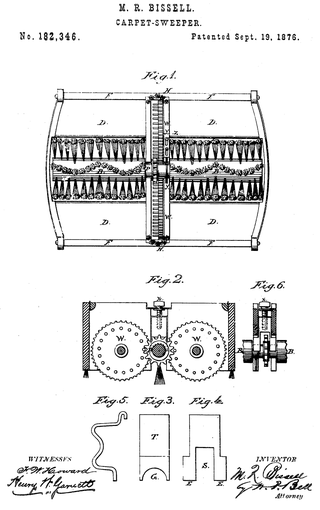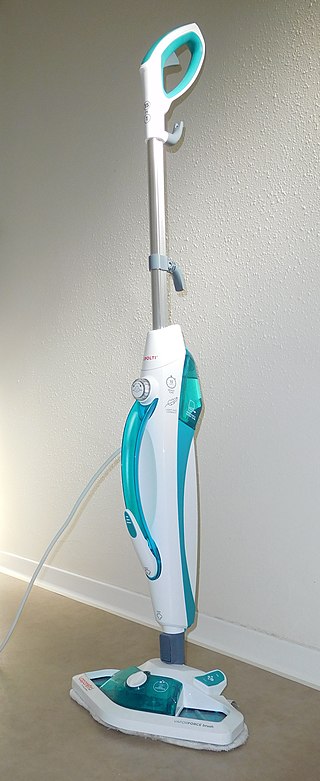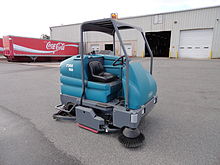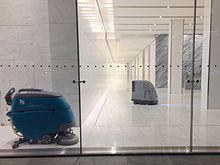
A vacuum cleaner, also known simply as a vacuum, is a device that uses suction in order to remove dirt from floors, upholstery, draperies, and other surfaces. It is generally electrically driven.

Roomba is a series of autonomous robotic vacuum cleaners made by the company iRobot. Introduced in September 2002, they have a set of sensors that enable them to navigate the floor area of a home. These sensors can detect the presence of obstacles, particularly dirty spots on the floor, and steep drops. Amazon announced the intent to purchase the parent company of the Roomba in August 2022, though the acquisition has been delayed by regulators in Europe.

A street sweeper or street cleaner may refer to a person's occupation or to a machine that cleans streets.

A mop is a mass or bundle of coarse strings or yarn, etc., or a piece of cloth, sponge or other absorbent material, attached to a pole or stick. It is used to soak up liquid, for cleaning floors and other surfaces, to mop up dust, or for other cleaning purposes.

Scooba was a floor-scrubbing robot made by iRobot. It was released in limited numbers in December 2005 for the Christmas season, with full production starting in early 2006. The company introduced a lower-priced version, the Scooba 5800, in the second half of 2006. It introduced a new Scooba 450 at CES 2014 in January 2014.

Swiffer is an American brand of cleaning products that is made by Procter & Gamble. Introduced in 1999, the brand uses the "razor-and-blades" business model, whereby the consumer purchases the handle assembly at a low price, but must continue to purchase replacement refills and pads over the lifespan of the product. Swiffer has become a half-billion dollar brand in fifteen countries.

A carpet sweeper is a mechanical device for the cleaning of carpets. They were popular before the introduction of the vacuum cleaner and have been largely superseded by them. However, they continue to be used in many home and commercial applications because they are lightweight and quiet, enabling users to quickly clean small messes up from the floor without disturbing patrons, patients, babies and pets, and because they do not require electricity to operate.

Carpet cleaning is performed to remove stains, dirt, and allergens from carpets. Common methods include hot water extraction, dry-cleaning, and vacuuming.

An automated pool cleaner is a vacuum cleaner that is designed to collect debris and sediment from swimming pools with minimal human intervention.

Hot Water Extraction (HWE) is a method of carpet cleaning. It involves a combination of hot water and cleaning agents being injected into the fibers of a carpet at high pressure and the lifted soil being removed by a powerful vacuum.

A cleaner or a cleaning operative is a type of industrial or domestic worker who does the cleaning.

Vapor steam cleaners or steam vapor systems are cleaning appliances or devices that use steam to quickly dry, clean, and sanitize surfaces. The steam is produced in a boiler that heats tap water to high temperatures to produce low-pressure, low moisture water vapor.

Floor cleaning is a major occupation throughout the world. The main job of most cleaners is to clean floors.

Evolution Robotics was an American technological company based in Pasadena, California. It specialized in robotics technologies, with computer vision, localization, and autonomous navigation products.
Dry carpet cleaning involves the use of specialized machines to clean carpets with recently developed chemical technologies that permit no-moisture or "very low moisture" (VLM) cleaning, resulting in carpet beautification, and removal of stains, dirt, grit, sand, and allergens. Clean carpets are recognized by manufacturers as being more visually pleasing, potentially longer-lasting and probably healthier than poorly maintained carpets.

A central vacuum cleaner is a type of vacuum cleaner appliance installed into a building as a semi-permanent fixture. Central vacuum systems are designed to remove dirt and debris from homes and buildings, by sending dirt particles through piping installed inside the walls to a collection container in a remote utility space. The power unit is a permanent fixture, usually installed in a basement, garage, or storage room, along with the collection container. Inlets are installed in walls throughout the building that attach to power hoses and other central vacuum accessories to remove dust, particles, and small debris from interior rooms. Most power hoses have a power switch located on the handle.

A robotic vacuum cleaner, sometimes called a robovac or a roomba as a generic trademark, is an autonomous robotic vacuum cleaner which has a limited vacuum floor cleaning system combined with sensors and robotic drives with programmable controllers and cleaning routines. Early designs included manual operation via remote control and a "self-drive" mode which allowed the machine to clean autonomously.

A domestic robot is a type of service robot, an autonomous robot that is primarily used for household chores, but may also be used for education, entertainment or therapy. While most domestic robots are simplistic, some are connected to Wi-Fi home networks or smart environments and are autonomous to a high degree. There were an estimated 16.3 million service robots in 2018.
Roborock is a Chinese consumer goods company known for its robotic sweeping and mopping devices and handheld cordless stick vacuums. Xiaomi played a key role in the company's founding.





















